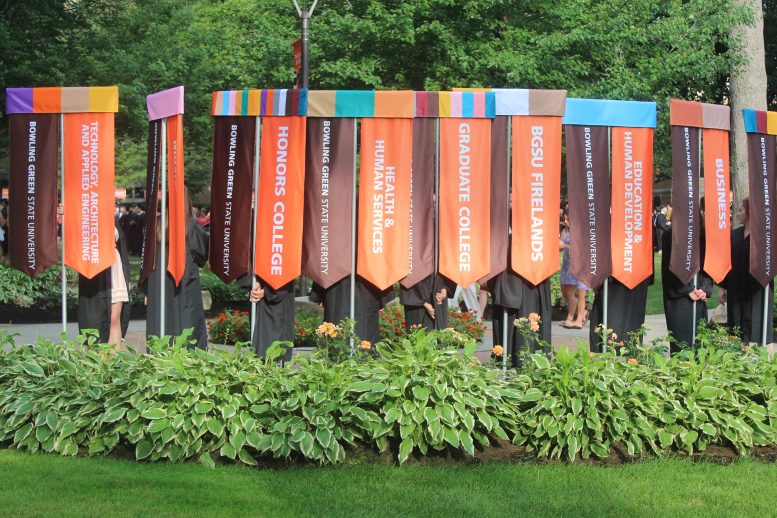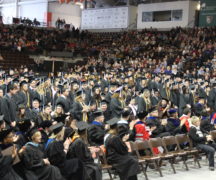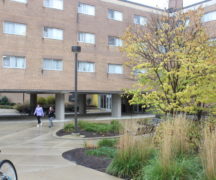By DAVID DUPONT
BG Independent News
While there was plenty of talk about Bowling Green State University’s financial crisis at Tuesday’s Faculty Senate meeting, there was also action that sets the scene for the post-COVID-19 world.
The senate approved the creation of four new programs, including laying the administrative groundwork for the new schools of nursing and physical therapy in the College of Health and Human Services as well as a masters of integrative design and a masters in logistics and systems engineering. These now will go to the Board of Trustees, and then to the state for final approval.
The programs fit into the vision, President Rodney Rogers spelled out in his opening remarks. BGSU is in a stronger position going into the financial crisis because it is one of the few state universities that has seen enrollment growth over the last five years. Some public universities have seen enrollment drop more than 20 percent.
Rogers attributed BGSU success in attracting students to the programs in: forensic science; aviation studies; nursing; mechatronics; the combination of philosophy, politics, economics and law; biology, especially marine biology; and finance.
This kind of programmatic innovation is central to BGSU’s future, Rogers said. “Our strength came in investing in programs that were in high demand, that are aligned with and built upon existing strengths.”
Maintaining that vision will determine what BGSU will look like when the pandemic is over. “I’m incredibly optimistic about the future of Bowling Green State University.”
In the case of the schools of nursing and physical therapy the senate approved the creation of the administrative units. The program and curriculum will be developed over the summer and the fall, Dean Jim Ciesla, of the College of Health and Human Services, said.
The new School of Nursing will provide pathway for the university’s pre-nursing students to earn their bachelor’s in nursing degrees, said Michelle Bussard.
The university has been depending on its consortium with the University of Toledo, which is ending. Through that program there were only 40 or so spots available. BGSU, she said, was sending its students and its money up north. The plan to merge with Mercy College didn’t pan out.
COVID-19, Bussard said, has highlighted the importance of nurses, and she expects growing demand. This year BGSU received 1,378 applicants for nursing with 768 accepted, and 141 having already committed.
BGSU also has programs that help registered nurses and licensed practical nurses earn their bachelor’s degrees. That degree is required , she said, by more and more hospitals.
Physical therapists are in growing demand, said Stephanie Thurmond, recently hired to lead the new school. At any given time, there are 600 job openings in both Michigan and Ohio.
The program will be delivered in a hybrid fashion with students studying the “didactic courses” online then traveling to northwest Ohio for immersive clinical training. That will enable the program to recruit students from across the nation.
As such, Ciesla said, it will help balance BGSU’s reliance on residential students.
The new masters programs are also in fields with increasing demand.
The master’s of science in logistics and systems engineering, said MD Sarder, would be the first graduate engineering program in the College of Technology, Architecture, and Applied Engineering.
More than 5 million people work in logistics, he said. The importance of the field was demonstrated during the COVID-19 pandemic as systems involving medical supplies and food were strained.
The College of Technology will work with the College of Business on the major. This, Sarder said, will mean that few new courses will have to be developed. Two new courses will be shared with systems engineering, and two will be specifically for the new masters.
Students will be able to complete the program online.
Sarder said the market will be threefold – international students who tend to look for engineering programs; out of state students attracted because it is online; and local working professionals
The masters of design in integrative design in the School of Art, explained Lori Young, addresses the change in the profession.
Designers are now called on to be involved at earlier stages in the process, so they collaborate with a range of other professionals. Companies that incorporate design into the heart of their operations generate almost twice the revenue and returns to shareholders, Young said.
This will be a hybrid, low-residency program allowing students to do much of their work away from campus. The target market, Young said, is both professionals already working in the field and looking to get another credential and those interested in entering the design field.





